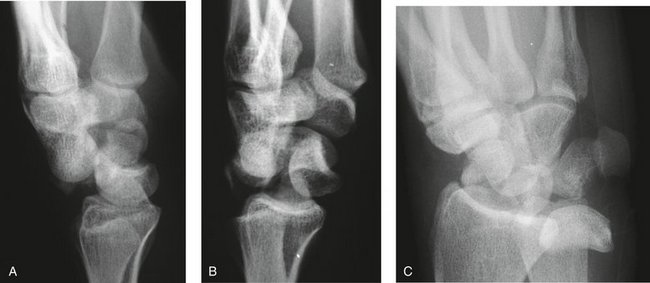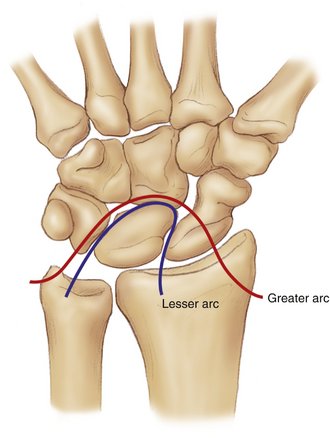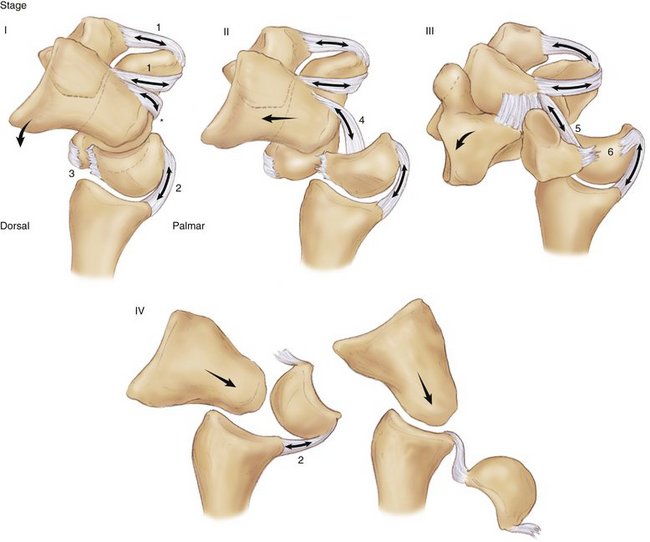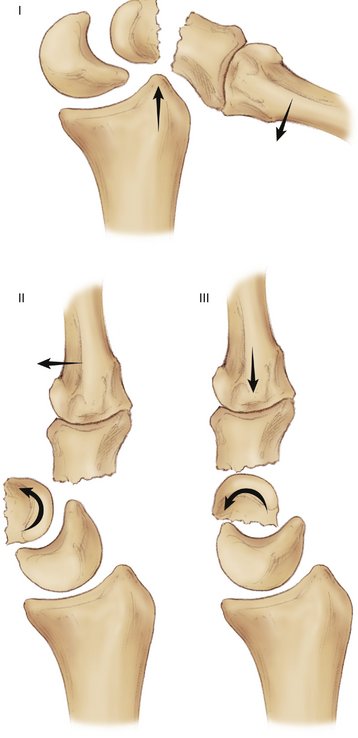CHAPTER 43 Perilunate Injuries of the Wrist
Perilunate injuries of the wrist include a spectrum of carpal dislocations and fracture-dislocations. These are rare injuries that often involve high-energy trauma, such as motor vehicle accidents, falls from a height, and industrial accidents. Despite the severity of trauma, initial diagnosis of these injuries tends to be delayed in 16% to 25% of cases.1 Young men are most frequently affected by these injuries. In one study1 of 166 perilunate injuries, the average age was 32 years with 97% males affected.1,2
Greater arc injuries occur when the force takes a path around the lunate of greater circumference. Greater arc injuries are perilunar fracture-dislocations of the wrist that combine ligament ruptures, bone avulsions, and carpal bone fractures in a variety of clinical forms. Greater arc perilunate fracture-dislocations most commonly involve the scaphoid, but also may include fractures of the radial and ulnar styloids, capitate, and triquetrum in any combination. Of perilunate dislocations, greater arc injuries are more common, with approximately two thirds of perilunate dislocations classified as greater arc injuries.1,3 The trans-scaphoid perilunate dislocation is the most common variant of this type of injury encountered in all published series. Of greater arc perilunate fracture-dislocations, 95% include a fracture through the middle third of the scaphoid. Usually the proximal fragment of the scaphoid remains attached to the lunate even if it has undergone a palmar dislocation; however, 3.8% of trans-scaphoid perilunate injuries may include a complete scapholunate ligament rupture.1,3–5 Fracture of the capitate also is occasionally encountered and is present in approximately 8% of all fracture-dislocations of the wrist.
Mechanism and Patterns of Injury
Mayfield3,6,7 described a spectrum of progressive perilunar instability that has greatly enhanced understanding of these injuries. Perilunate injuries are divided into four stages based on the concept of a sequential pattern of traumatic intercarpal wrist instability.
Mayfield also noted that carpal fractures may occur in perilunate injuries in lieu of ligament ruptures. In these cases, the force is concentrated on the carpus away from the lunate as it progresses from radial to ulnar, which results in the carpal bone fractures. The injuries that result are called greater arc injuries because the route of injury includes a path more remote from the lunate than lesser arc injuries (Fig. 43-1).
Progressive perilunar instability as described by Mayfield has four stages that follow a common sequence after exposure of the wrist to forceful hyperextension with a strong supination torque (Fig. 43-2). Stage I injuries result in scapholunate dissociation.6,7 Hyperextension of the scaphoid places a strong torque on the lunate and its ligaments. The extrinsic palmar and dorsal ligaments tightly stabilize the lunate, and the force is concentrated on the scapholunate ligament, which ultimately begins to tear from palmar to dorsal. If the force is strong enough, the scapholunate ligament completely ruptures, completing stage I.
In stage IV injuries, the lunate is forced volarly to dislocate into the carpal tunnel through the opened space of Poirier. Isolated volar dislocations of the lunate are the end stage of the spectrum of progressive perilunar instability. Lunate dislocations are divided into three types. Type 1 lunate dislocations result in a lunate that has rotated palmarly up to 90 degrees. Type 2 lunate dislocations produce a lunate with more than 90 degrees of palmar rotation as it is hinged on the short radiolunate ligament. Type 3 injuries result in dislocation of the lunate into the carpal tunnel. Reverse perilunar instabilities result from hyperpronation of the wrist and may be the mechanism for rare perilunate injuries with palmar dislocation of the midcarpal joint.3
In greater arc injuries, the variable pattern of fracture might include avulsion of the radial styloid or fracture of the scaphoid, capitate, triquetrum, or ulnar styloid. The most common pattern observed in greater arc injuries is the trans-scaphoid perilunate fracture-dislocation. The trans-scaphoid variant is observed in 60% of perilunate wrist injuries.1,3,6 The scaphoid fracture is through the waist in 60% to 72% of cases.1,3 The scaphoid may fracture at any level, however, including the proximal pole.
Fracture of the capitate may occur and be part of the “scaphocapitate” syndrome.3,6,8–10 This injury consists of a variation of a greater arc perilunate fracture-dislocation, in which the scaphoid and the capitate are fractured. The capitate fracture typically occurs proximally at the proximal neck of the bone. Complete rotation of the capitate fragment is typical with the proximal fragment often rotated 90 to 180 degrees. The mechanism of the fracture seems to involve a direct impact of the capitate against the dorsal lip of the radius with the wrist in a hyperextended and ulnarly deviated position. Rotation of the proximal capitate fragment is a result of the return of the distal fragment to its neutral position after dislocation (Fig. 43-3).
Presentation and Diagnosis
Patients may present with symptoms of median or ulnar nerve compression. The incidence of acute carpal tunnel syndrome manifesting with perilunate injury ranges from 16% to 46%.11 Most patients have resolution of nerve compression after closed reduction, but persistent nerve dysfunction after closed reduction may require urgent surgical decompression. Close attention should be paid to the patients’ neurovascular status, and the status of the median nerve in particular should be carefully established before and after reduction.
A standard four-view wrist series should be diagnostic of perilunate injuries and exhibit typical features. Most importantly, the dislocation of the midcarpal joint is best appreciated on the lateral view where lunocapitate dissociation can be easily visualized. The position of the lunate is best determined on the lateral view, which may reveal malrotation or dislocation of the lunate (Fig. 43-4).

FIGURE 43-4 A, The lateral injury film reveals dislocation of the midcarpal joint with dorsal dislocation of the capitate from the lunate. B, Midcarpal dislocation accompanied with palmar rotation of the lunate. C, Palmar dislocation of the lunate (Mayfield stage 4).
In perilunate injury, one also may appreciate on the anteroposterior view that there are radiographic breaks in the smooth arcs between the carpal rows described by Gilula.12 These arcs are named after Gilula, the radiologist who described the concept of the greater and lesser arc injuries. Additionally, the carpus appears foreshortened with loss of carpal height. Malrotation of the lunate produces a “triangular-shaped” lunate that overlaps the capitate on the anteroposterior radiograph (Fig. 43-5










